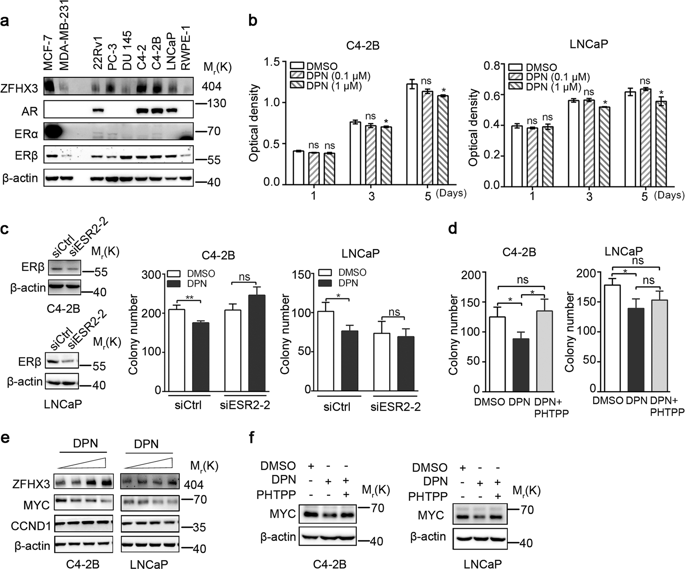Oncogenesis ( IF 5.9 ) Pub Date : 2019-04-12 , DOI: 10.1038/s41389-019-0138-y Qingxia Hu , Baotong Zhang , Rui Chen , Changying Fu , Jun A , Xing Fu , Juan Li , Liya Fu , Zhiqian Zhang , Jin-Tang Dong

|
Both estrogen receptor 2 (ESR2, also known as estrogen receptor beta (ERβ)) and the zinc-finger homeobox 3 (ZFHX3, also known as ATBF1 for AT motif-binding factor 1) modulate prostate development and suppress prostatic tumorigenesis in mice. ZFHX3 is integral to proper functions of ESR1 (i.e., estrogen receptor alpha (ERα)), which belongs to the same family of proteins as ESR2, but is hardly expressed in prostate epithelial cells. It is not clear how ZFHX3 suppresses prostatic tumorigenesis. In this study, we investigated whether ZFHX3 and ERβ functionally interact with each other in the suppression of prostatic tumorigenesis. In two androgen receptor (AR)-positive prostate cancer cell lines, C4-2B and LNCaP, we first validated ERβ’s tumor suppressor activity indicated by the inhibition of cell proliferation and repression of MYC expression. We found that loss of ZFHX3 increased cell proliferation and MYC expression, and downregulation of MYC was necessary for ZFHX3 to inhibit cell proliferation in the same cell lines. Importantly, loss of ZFHX3 prevented ERβ from suppressing cell proliferation and repressing MYC transcription. Biochemically, ERβ and ZFHX3 physically interacted with each other and they both occupied the same region of the common MYC promoter, even though ZFHX3 also bound to another region of the MYC promoter. Higher levels of ZFHX3 and ERβ in human prostate cancer tissue samples correlated with better patient survival. These findings establish MYC repression as a mechanism for ZFHX3’s tumor suppressor activity and ZFHX3 as an indispensable factor for ERβ’s tumor suppressor activity in prostate cancer cells. Our data also suggest that intact ZFHX3 function is required for using ERβ-selective agonists to effectively treat prostate cancer.
中文翻译:

ZFHX3对于ERβ抑制通过MYC下调前列腺癌细胞中的细胞增殖是必不可少的
雌激素受体2(ESR2,也称为雌激素受体β(ERβ))和锌指同源盒3(ZFHX3,也称为AT基序结合因子1的ATBF1)均可调节前列腺的发育并抑制小鼠前列腺癌的发生。ZFHX3是ESR1(即,雌激素受体α(ERα))的正常功能所必需的,ESR1与ESR2属于同一家族的蛋白质,但在前列腺上皮细胞中几乎不表达。尚不清楚ZFHX3如何抑制前列腺癌的发生。在这项研究中,我们调查了ZFHX3和ERβ在抑制前列腺癌发生中功能上是否相互影响。在两个雄激素受体(AR)阳性前列腺癌细胞系C4-2B和LNCaP中,我们首先验证了抑制细胞增殖和抑制MYC表达所指示的ERβ的肿瘤抑制活性。我们发现ZFHX3的缺失会增加细胞增殖和MYC表达,而MYC的下调对于ZFHX3抑制相同细胞系中的细胞增殖是必要的。重要的是,ZFHX3的丢失阻止了ERβ抑制细胞增殖和抑制MYC转录。在生物化学上,即使ZFHX3也与MYC启动子的另一个区域结合,ERβ和ZFHX3彼此物理相互作用,并且它们都占据了共同MYC启动子的相同区域。人前列腺癌组织样品中较高水平的ZFHX3和ERβ与患者更好的存活率相关。这些发现确立了MYC抑制是ZFHX3的肿瘤抑制活性的机制,而ZFHX3是ERP在前列腺癌细胞中抑制肿瘤活性的必不可少的因素。我们的数据还表明,使用ERβ选择性激动剂有效治疗前列腺癌需要完整的ZFHX3功能。











































 京公网安备 11010802027423号
京公网安备 11010802027423号